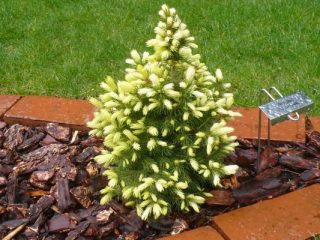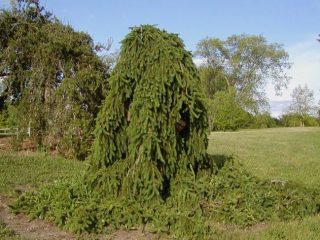Content
Prickly spruces are common in western America. In Colorado, this plant is considered a symbol of perseverance and purity. El Fat Albert is distinguished by its luxurious blue crown. The variety is characterized by low maintenance and frost resistance.
Origin story

El Fat Albert loves open spaces and slightly acidic soil
The variety appeared in 1978 in one of the Oregon nurseries. The species was discovered by breeder Don Howes, who specialized in conifers. The man was a fan of the Iseli nursery, so he decided to name his brainchild in honor of the merry fellow Albert. The character was distinguished by its large dimensions and was invented by the famous comedian Bill Cosby.

Fat Albert gained wide popularity and spread across all continents
The variety has won several awards, and in mid-2012 it was awarded an award from the official royal community of gardeners in England.
Description of blue spruce Fat Albert with photo
This plant is one of the few that can boast a geometrically correct crown shape. This situation is due to a strong foundation.It holds the entire mass of branches and withstands strong winds. A detailed description of the Fat Albert prickly spruce is presented below.
Height of Fat Albert spruce
The species boasts rapid growth. In one year, the height of the top can rise to 20, and sometimes up to 30 cm. At the age of 10 years it reaches 3 m, adult spruce trees grow to 15-17 m. The average diameter of the crown is 3.5 m. Fat Albert is not afraid of wet snow and does not bend under its weight.
The branches extend from the trunk at an angle close to a straight line, forming tiers. The crown is characterized by density. The branches are quite prickly, the needles are up to 3.5 cm in length. The needles have a distinctive blue tint that does not disappear throughout the life of the plant. The color is not affected by the ambient temperature, as happens with some varieties.
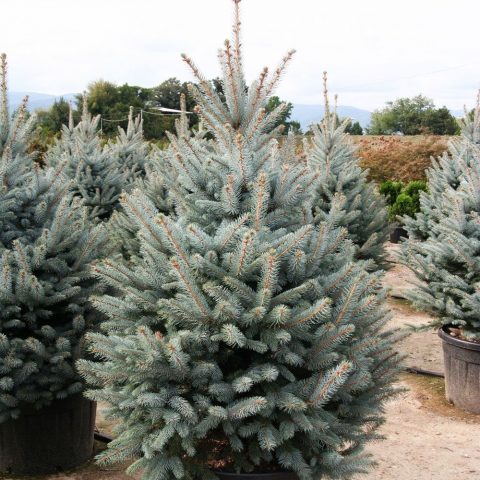
Fat Albert's branches always face the sun
In early to mid-spring, the shoots become overgrown with cones. They are shaped like a chicken egg. Mature spruce trees form large cones that can have different colors - from green to purple. With the arrival of the summer sun, the fruits turn brown and begin to fall off towards the end of autumn.
Distinctive features of the variety are a cone-shaped crown and raised branches. This creates an interesting appearance and attracts the attention of gardeners from different countries.
Fat Albert loves sunny weather and a temperate climate. Tolerates frequent watering well. The needles of a plant located in the shade have a darker shade.It lives in different regions of Russia, tolerates polluted air, which is why it is used to improve areas near factories and highways.
Frost resistance
Despite its love for the sun, spruce tolerates negative temperatures well (in some cases down to -40 °C) and does not break in strong winds.

Mature spruce Fat Albert calmly endures the Russian winter
Advantages and disadvantages
Culture has a beautiful appearance, which attracts popular designers. Thanks to its unpretentiousness, Fat Albert can be grown in different climatic conditions.

The plant grows quickly and gets along well even in northern regions
Advantages:
- strong trunk and branches;
- a small number of pests;
- disease resistance;
- the cones last for several months;
- frost resistance.
Flaws:
- almost does not grow in arid and humid climates.
Landing rules
For spruce, choose open areas with access to the sun. If the soil is fertile enough, Fat Albert will grow very quickly. The crop does not require regular watering, but in hot weather it is advisable to spray the plant. When planted in wet soil, the variety may wither, so you need to choose the soil carefully. Swampy terrain is absolutely not suitable.
Usually they buy ready-made seedlings. This is a common planting method that produces good results in a short time. Experts recommend monitoring the position of the root shoot - when planting, it should be at the same level as the top layer of soil.

Fat Albert can be temporarily transplanted into a plastic pot
Features of care
In general, this is a rather unpretentious plant, but you should not forget about simple care rules. Fat Albert needs to be watered and fed periodically for the variety to feel comfortable. To maintain beauty, you can prune. The variety practically does not get sick, but if the owner waters it frequently, the spruce will begin to fade.
Reproduction
Reproduction is allowed in two ways - seeds and cuttings. For the first, you need to leave the cone in a warm place until the fruit opens on its own. Then they take out the seeds, deepen them in wet sand and put them in the refrigerator until the beginning of spring. Peat or ordinary garden soil is used as a substrate. Before planting, it is actively watered. The seedlings are placed in recesses at a distance of 30 cm from each other. Upon reaching the age of two, they are planted 1 m.
Propagation using cuttings is easier. It is enough to cut off the branches of an adult plant, remove the needles and soak in potassium permanganate. Then the branch is placed in fertilized soil, sprinkled with sand, watered and covered with film. In order for the seedling to grow quickly, you can irrigate the soil about 3-4 times a day.

Maintaining distance between plants is necessary for normal nutrition
Diseases and pests
El Fat Albert almost never gets sick and does not suffer from pests. The tree takes root well in urban environments and is not afraid of harmful gases. Moreover, this does not in any way affect its beauty, so the species is considered one of the best for breeding.

The main pests of the plant are leaf rollers, spider mites and aphids.
Application in landscape design
El Fat Albert is distinguished by its decorative characteristics. Designers use these properties in landscape design,
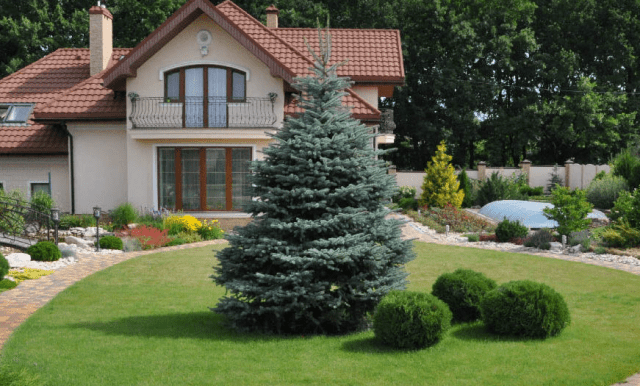
Combine the variety with other plants - spruce trees, shrubs, flowers
The tree looks best in small, well-maintained areas, such as rock landscaping.
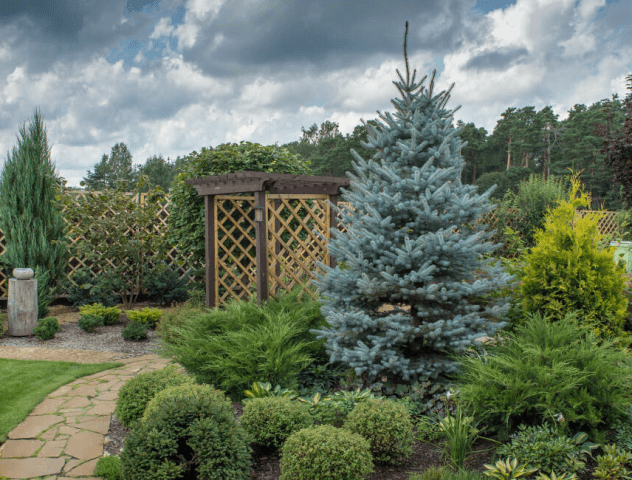
Ephedras are used both in group and single versions
Conclusion
El Fat Albert is a strong ornamental plant that is not afraid of either the sun or frost. Thanks to these qualities, it has found distribution in the northern regions. In order for a tree to grow beautiful, you need to follow the basic rules of planting. Don’t forget about watering, especially during hot periods. Owners pay attention to the unpretentiousness of the crop and resistance to negative temperatures. The disadvantage of the plant is poor growth in wet soil and drought conditions.
Reviews of prickly spruce Fat Albert
